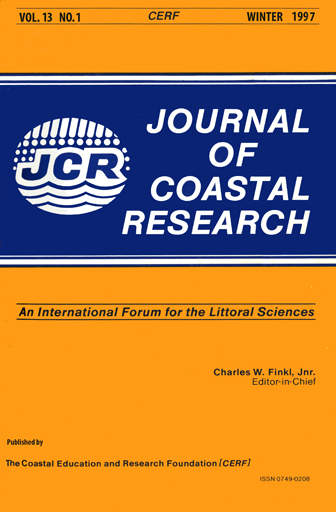An Evaluation of the Economic Performance of the U.S. Army Corps of Engineers Shore Protection Program
Keywords:
Coastal erosion, beach replenishment, restoration, benefit-cost analysis, beachfront development, coastal environmentsAbstract
This study of the U.S. Army Corps of Engineers' (USACE) shore protection program was undertaken as a result of a request from the Office of Management and Budget (OMB). The investigation disclosed that the USACE shoreline protection program covers 8 percent of the nation's 2,700 miles of critically eroding shoreline and consists of 82 specifically authorized projects. Total actual expenditures, including periodic nourishment, for these 82 projects from 1950 to 1995 have been $731 million. When updated to 1995 dollars this expenditure becomes $1,662 million. Over the period of time covered by this study (l950-current) the program has shifted from primarily "hard" structures (groins, seawalls, breakwaters, etc.) to primarily "soft" beach restoration and nourishment through placement of sand. Beach restoration and nourishment is also the most environmentally compatible shore protection measure. The projects receive intense preconstruction coordination with environmental agencies to assure no long term adverse environmental impacts result from the projects. Over this same time period, as a result of Administration policy and law, the program has shifted from primarily recreation oriented to one of protection for storm damage reduction.
From the standpoint of program cost and volumes of sand emplacements the evaluation of the long-term performance of the program shows that it is a well-managed and cost-effective program. Overall, costs were slightly less than estimated, and overall quantities of sand were slightly higher than estimated. Whether or not the projects are performing as expected from a benefit standpoint, however, is very difficult to determine. Because of the high variable and largely unpredictable nature of coastal storms, the "actual" storm damage reduction benefits of shore protection projects can differ greatly from those forecasted during planning and design. The key to the benefit-cost analysis is that the benefits are estimated based on a probabalistic assumption that, over the period of analysis (generally 50 years), a comparable sequence of events will occur as in the past, causing a comparable level of property damages. Hence, the longer the period of record, the more likely that the "estimated" benefits will converge on the "actual" or measured benefits (and costs).
One item of specific concern to OMB was that of induced development, i.e., do shore protection projects' lead to more growth and development in protected areas, and hence, ultimately to increases in storm damages rather than a reduction in damages. Three specific economic analyses were applied during the course of the study to determine whether USACE shore protection projects induce development in the areas they protect. These three complementary studies were: (1) a survey of beachfront community residents; (2) an econometric model of beachfront development;and (3) an econometric analysis of beachfront housing prices. None of these approaches could verify that there is a measurable induced development link. The analyses demonstrated that the primary determinant of development of beachfront communities is growth in beachfront demand based on rising income and employment in noncoastal areas, rather than the presence or absence of a shore protection project. In fact, there is limited public awareness of the Federal shore protection program, where Federal projects currently exist, and of the involvement of the USACE in reducing risks through project construction.


